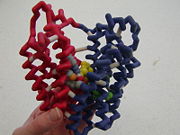Lactose Permease
From Proteopedia
This page refers to a physical model based on 1pv7 from the MSOE Center for BioMolecular Modeling
Function of Lactose Permease
Lactose Permease is a transmembrane protein that facilitates the passage of lactose across the phospholipid bi-layer of the cell membrane. The transport mechanism used is an active co-transport that uses the inwardly directed H+ electrochemical gradient as its driving force. As a result, the lactose is accompanied from the periplasm to the cytoplasm of the celll by an H+ proton.
Lactose is a disaccharide carbohydrate found primarily in mammalian milk. The disaccharide consists of the monosacharides glucose and galactose. When the lactose is ingested and absorbed into the cell, the enzyme lactase breaks the disaccharide into its monosaccharide subunits. These are in turn used in the cellular respiration process and broken down further into energy for the cell.
Structure of Lactose Permease
| |||||||||||
Proteopedia Page Contributors and Editors (what is this?)
Savannah Anderson, Michal Harel, Eran Hodis, Alexander Berchansky, David Canner, Ralf Stephan


